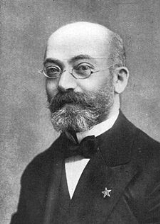
La Espero
Encyclopedia
"La Espero" is a poem written by L. L. Zamenhof
(1859–1917), the initiator of the Esperanto
language. The song is often used as the anthem
of Esperanto, and is now usually sung to a triumphal march
composed by Félicien Menu de Ménil
(although there is an earlier, less martial tune created in 1891 by Claes Adelsköld
, as well as a number of others less well-known). It is sometimes referred to as the hymn
of the Esperanto movement.
Some Esperantists object to the use of terms like "hymn" or "anthem" for La Espero, arguing that these terms have religious and nationalist overtones respectively.
L. L. Zamenhof
Ludwig Lazarus Zamenhof December 15, 1859 – April 14, 1917) was the inventor of Esperanto, the most successful constructed language designed for international communication.-Cultural background:...
(1859–1917), the initiator of the Esperanto
Esperanto
is the most widely spoken constructed international auxiliary language. Its name derives from Doktoro Esperanto , the pseudonym under which L. L. Zamenhof published the first book detailing Esperanto, the Unua Libro, in 1887...
language. The song is often used as the anthem
Anthem
The term anthem means either a specific form of Anglican church music , or more generally, a song of celebration, usually acting as a symbol for a distinct group of people, as in the term "national anthem" or "sports anthem".-Etymology:The word is derived from the Greek via Old English , a word...
of Esperanto, and is now usually sung to a triumphal march
March (music)
A march, as a musical genre, is a piece of music with a strong regular rhythm which in origin was expressly written for marching to and most frequently performed by a military band. In mood, marches range from the moving death march in Wagner's Götterdämmerung to the brisk military marches of John...
composed by Félicien Menu de Ménil
Félicien Menu de Ménil
Félicien Menu de Ménil was a French composer and Esperanto enthusiast best known for his musical setting of Ludwig Zamenhof's poem La Espero.-References:...
(although there is an earlier, less martial tune created in 1891 by Claes Adelsköld
Claes Adelsköld
Claes Adolf Adelsköld was a Swedish civil engineer, railway engineer, Army officer, member of the upper house of the Parliament of Sweden, and writer.- Background :...
, as well as a number of others less well-known). It is sometimes referred to as the hymn
Hymn
A hymn is a type of song, usually religious, specifically written for the purpose of praise, adoration or prayer, and typically addressed to a deity or deities, or to a prominent figure or personification...
of the Esperanto movement.
Some Esperantists object to the use of terms like "hymn" or "anthem" for La Espero, arguing that these terms have religious and nationalist overtones respectively.
La EsperoEn la mondon venis nova sento,tra la mondo iras forta voko; per flugiloj de facila vento nun de loko flugu ĝi al loko. Ne al glavo sangon soifanta ĝi la homan tiras familion: al la mond' eterne militanta ĝi promesas sanktan harmonion. Sub la sankta signo de l' espero kolektiĝas pacaj batalantoj, kaj rapide kreskas la afero per laboro de la esperantoj. Forte staras muroj de miljaroj inter la popoloj dividitaj; sed dissaltos la obstinaj baroj, per la sankta amo disbatitaj. Sur neŭtrala lingva fundamento, komprenante unu la alian, la popoloj faros en konsento unu grandan rondon familian. Nia diligenta kolegaro en laboro paca ne laciĝos, ĝis la bela sonĝo de l' homaro por eterna ben' efektiviĝos. |
The HopeInto the world came a new feeling,through the world goes a powerful call; by means of wings of a gentle wind now let it fly from place to place. Not to the sword thirsting for blood does it draw the human family: to the world eternally fighting it promises sacred harmony. Under the sacred sign of the hope the peaceful fighters gather, and this affair quickly grows by the labours of those who hope. The walls of millennia stand firm between the divided peoples; but the stubborn barriers will jump apart, knocked apart by the sacred love. On a neutral language basis, understanding one another, the peoples will make in agreement one great family circle. Our diligent set of colleagues in peaceful labor will never tire, until the beautiful dream of humanity for eternal blessing is realized. |

